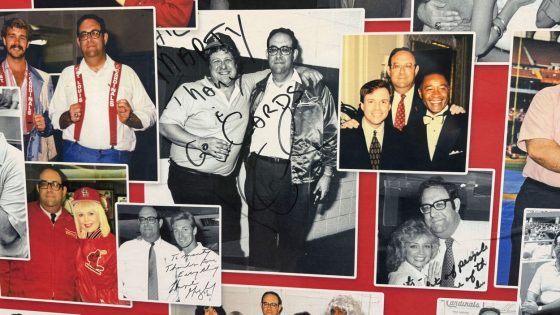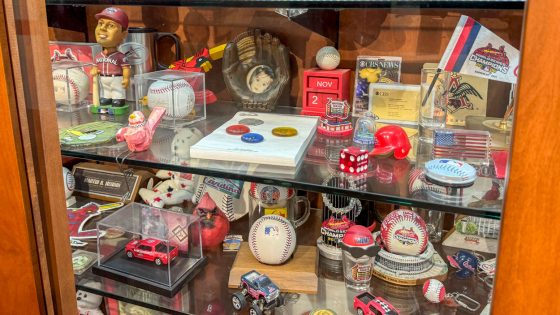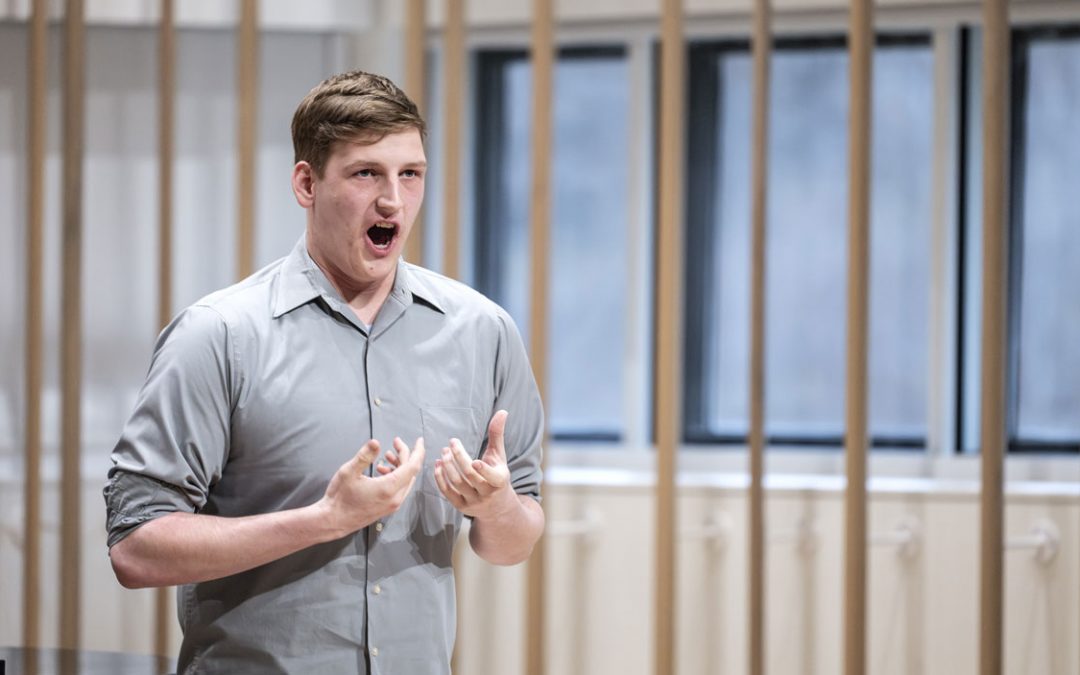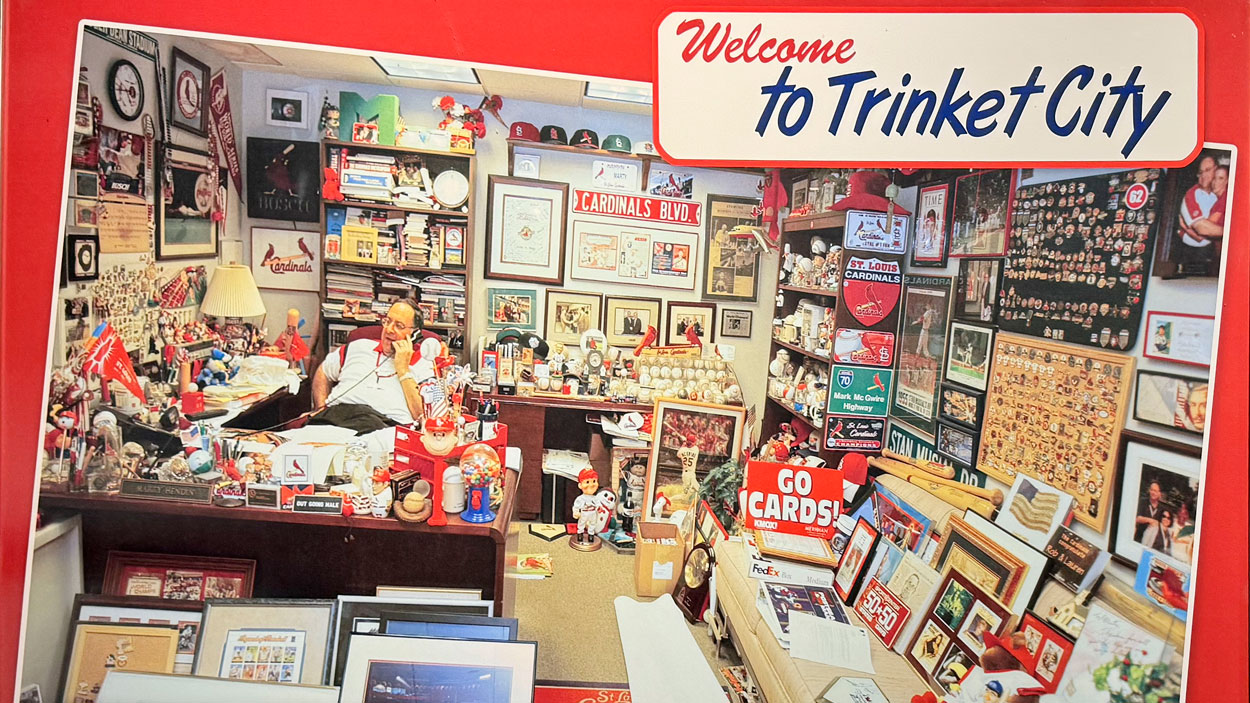
Marty Hendin’s office at Busch Stadium, dubbed Trinket City by those in the organization, was legendary for its collection of unique and eclectic Cardinals memorabilia. (Photos by Ryan Fagan)
More than a decade after his passing, Marty Hendin’s legacy and his famed Trinket City are thriving at Busch Stadium.
Hendin, a 1970 graduate of the University of Missouri–St. Louis, worked for the St. Louis Cardinals from 1973 until his death in 2008, holding various marketing, public relations and community relations positions in the front office. During his time with the club, Hendin amassed a mind-boggling number of unique, quirky and one-of-a-kind pieces of Cardinals memorabilia, along with hundreds of photographs and autographs of celebrities who visited the stadium.
His collection, naturally and continually fueled by his unrelenting passion for his ballclub, became so legendary that his office was dubbed Trinket City.
“One thing I always remember was that he had so much stuff, there wasn’t a spot – other than maybe a couple of chairs in front of his desk – where you could sit,” Brian Bartow, who started with the Cardinals as an intern in 1985 and has been director of media relations since 1994, said with a laugh. “He had a large sofa in his office, but the thing was filled up with all kinds of memorabilia, Cardinals pillows, blankets and anything. It was hard to find a spot to sit.”
As a measure of Hendin’s impact on St. Louis’ most iconic sports franchise, shortly after his sudden passing at 59 years old in 2008, the Cardinals – who moved into their new stadium in 2006 – gave Hendin’s Trinket City a new home, a place of prominence on the inner concourse right next to the “First Pitch Room” that bears his name, too. Everyone who throws out a ceremonial first pitch and every group that comes through for a behind-the-scenes tour of the stadium gets the chance to gawk at the display, which is more than 20 feet wide and seven feet high in the middle.
The bobbleheads, figurines, press pins and other knickknacks delight the onlookers, as do the collages on either side of the main display. On the left is a photo of Hendin in his beloved office, and on the right is a photomontage of Hendin with a wide spectrum of celebrities and athletes, everyone from John Goodman, Sammy Davis Jr. and Bob Hope to Stan Musial, Ozzie Smith and Jackie Joyner-Kersee. Bob Costas, Tony Bennett and Kurt Warner are there with Hendin, too.
Tour groups aren’t the only ones who notice. The display is right on the path opposing players take from their team busses to the visitors’ clubhouse.
“Obviously, you notice it,” Pirates outfielder Andrew McCutchen told UMSL Daily with a grin.
Before he signed with the Cardinals in the offseason, Brandon Crawford was a regular visitor to the other side of the ballpark during his time with the San Francisco Giants from 2011 to 2023. He said he definitely stopped to look at the display.
“Every ballpark kind of has its own uniqueness, but typically on the way to visiting clubhouse you don’t get to see stuff like that,” he said. “Obviously, that’s some history that is cherished with this franchise. You see that in a ballpark, and you know it’s a franchise that appreciates its history.”
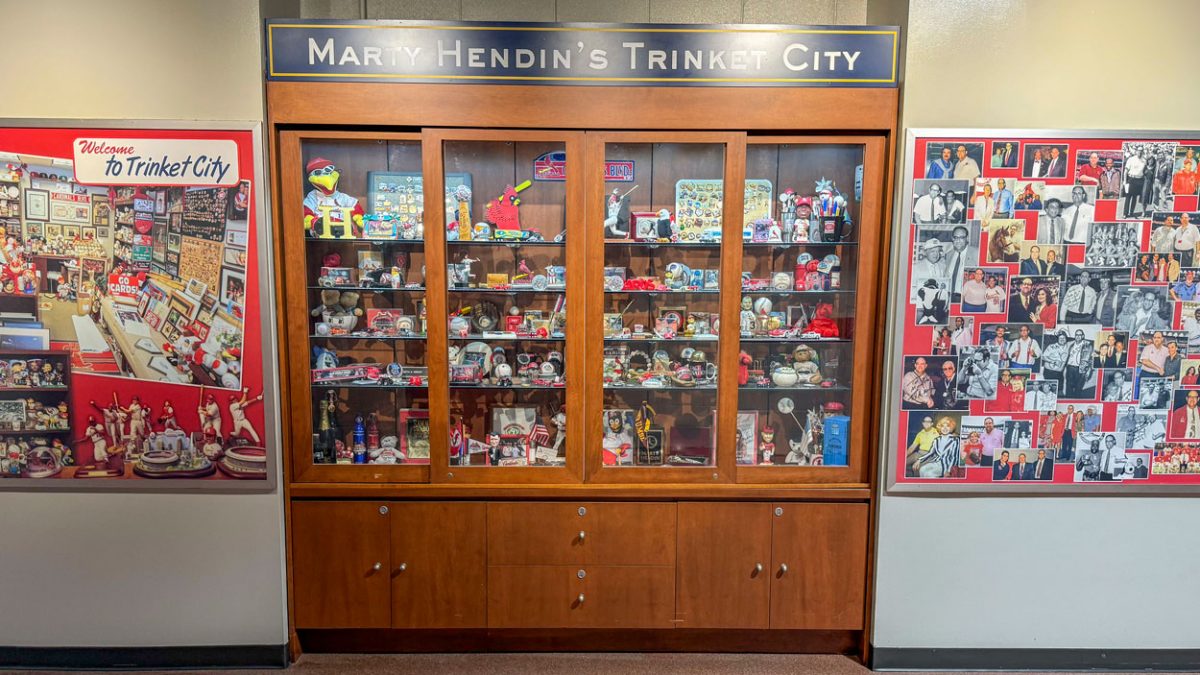
After his death in 2008, the Cardinals created this display of Hendin’s collection and put it right next to the “First Pitch Room” that bears his name.
And right there in the middle of the display, beside a picture of the mascot, Fredbird – local legend credits the idea to Hendin, though he was so great at deflecting praise that nobody’s exactly sure if the idea for the treasured mascot was solely his – sits a little UMSL flag.
Hendin loved his alma mater. A graduate of University City High School, Hendin was president of UMSL’s Alumni Association from 1973-77, was named a Distinguished Alumni Award Recipient in 1990 and was inducted into the UMSL Sports Hall of Fame in 2003. For several years after his death, part of his Trinket City collection was on display at UMSL’s Millennium Student Center, though those items were eventually returned to the family.
“He was very proud of his connection to UMSL and what it meant and making sure that everyone understood what a great university that was, and what a big impact it had on his life,” said Matt Gifford, the Cardinals’ vice president of stadium operations.
Gifford started with the Cardinals in 1996, and after a couple of months, his life changed when he became Hendin’s intern.
“There was no better way to learn about Cardinals baseball and being a sports professional than working for Marty,” Gifford said. “He was bigger than life. Of everyone at the ballpark, no one bled Cardinal baseball more than him. I hope that each day that I’m here, a piece of Marty is shared with the young people here.”
Both Gifford and Bartow insisted that nobody at the ballpark cared more about wins and losses than Hendin, who would stay up and watch pretty much every game, even on the West Coast.
“He was just so proud of being a Cardinal, proud of St. Louis,” Bartow said. “What a one-of-a-kind guy. He poured his whole life into the franchise.”
With all due respect to Trinket City – which merited its own chapter in Post-Dispatch writer Derrick Goold’s 2019 book, “100 Things Cardinals Fans Should Know & Do Before They Die” – Hendin’s true legacy with the Cardinals rests in his influence on the relationship between his team and his city, which still resonates through the organization.
“He cared so much about our impact on the community and how the players and staff affected everyone, whether they were a fan or a new person coming to experience what Cardinal baseball was all about,” Gifford said. “He was just such a great mentor to me.”
As Gifford moved up through the organization, even though he no longer worked directly for him, Hendin remained his mentor. They’d play a little game when Gifford stopped into Trinket City.
“He would say, ‘Hey, can you find what I have that’s new?’” Gifford said with a laugh. “You stand there in his office long enough waiting for him to get off the phone, and the way my brain works, I would look around and I always knew what was new. I’d point it out and he would just laugh. He was so proud of everything there because everything had meaning to him.”
When the Cardinals purchased a minor-league franchise in El Paso and moved that club to Springfield, Missouri, for the 2005 season, Hendin’s former intern was the ideal choice as general manager of the organization’s new Double-A franchise.
“We started from scratch, and a lot of what Marty taught me and the great things he did, that’s still part of that culture in Springfield,” Gifford said. “That’s part of his legacy; it’s bigger than just Busch Stadium and the Cardinals. It permeates not only to Springfield, but to Memphis because when we bought that Triple-A franchise, we tried to emulate what he did in the community.”
That legacy still lives on at his university, too.
When UMSL honored 60 alumni in the 2023-24 school year as part of the university’s 60th anniversary, Hendin was an easy choice to be included. Hendin helped create the UMSL Sports Hall of Fame, and there’s also a scholarship in his name, the Marty Hendin UMSL Rivermen Scholarship.
“He was always,” Gifford said, “trying to give back to his school.”

